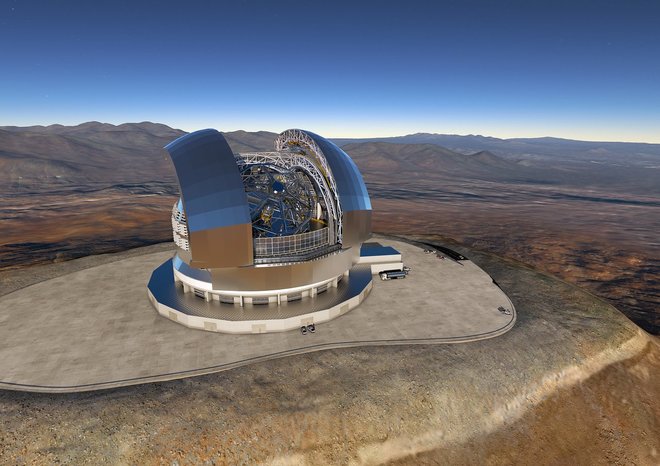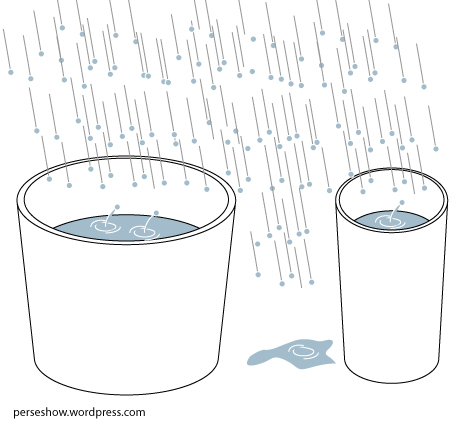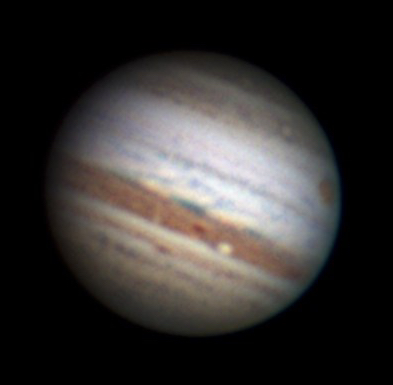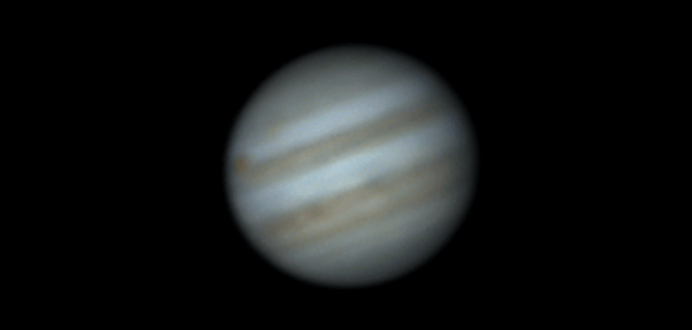
Have you seen one of these guys before?
You probably have, even if you don’t recognize this brand-new innovation. This is the European Extremely Large Telescope, or the E-ELT. I know, imaginative name, huh? Anyway, it’s not all that different from one of those white observatory domes you’re used to seeing.
Astronomers keep building new observatories. They keep putting new telescopes into space—Hubble, Spitzer, and James Webb, to name a few. But the common goal of all the telescopes they build is to make telescopes that are as big as possibly possible.
Why? I mean, are astronomers just huge braggarts that like to impress us all with their big toys?
Well…I’ll admit that we astronomers have a lot of fun with our toys. But we need huge telescopes for a much better reason than bragging.
Imagine two buckets, a big one and a small one. Which one do you think will catch more rain?

If you guessed the larger bucket…well, you’re right. I guess that one’s just common sense. But my point is that telescopes work in the same way. A larger telescope will catch more light than a smaller telescope.
But why do telescopes need to capture a lot of light?
Well, imagine you’re in a cave. If you want to be able to see, are you going to use the dimmest flashlight you can find, or the brightest?
Did you guess the brightest flashlight? If you did, good for you. Here’s a hint, when it comes to light—the more light, the brighter.
And what’s the darkest place you can think of?
Well…I guess a cave is a valid answer. But I’m thinking deep space. And I’m thinking that in order for us to see what’s out there, we need a lot of light.
Good thing there’s already a lot of light out there. We just need to catch it.
One of a telescope’s powers is the ability to collect light, and how much it collects depends on its diameter (or, more specifically, the surface area of its primary mirror or lens). More area means more room for light to fall in, which means a brighter image.
Another one of a telescope’s powers is resolution. And in this case, collecting more light means seeing more detail.
How many stars do you think are in this image?

If you said “one,” I agree…but let’s take a look at the same object through a better telescope.
Now how many stars are there?

This image still isn’t very good…but now you can at least tell that there are two different stars there.
A telescope’s resolution is how much detail it can see. The more detail, the better, because we want to know as much as we can about all those distant objects. Imagine if we could see the two stars above as well as our own sun?
And by that…I mean the way we see it through a solar telescope.

Everything we know about any object—including our sun—comes from how well we can see its details. We can observe sunspots, prominences, flares, coronal mass ejections, spicules, granulation, seismology, and so much more just from observing our own star.
Imagine if we could see the same level of detail on other stars? Right now, we can compare our sun to other stars and get a good idea of what might exist elsewhere in the universe. But what if we could directly observe those things elsewhere?
So naturally, astronomers want the most resolution they can get. And—surprise! —resolution comes hand in hand with telescope diameter.
By the way, did you notice those cool little blurry rings around the stars up above? That’s called a diffraction fringe, and we can’t see any detail smaller than that. But that’s what telescope diameter fixes for us. The larger the diameter, the smaller the fringe.
We can never eliminate diffraction completely…but we can come pretty darn close, the larger the telescopes we build.
Unfortunately, though, telescopes aren’t entirely in control of how well they see.

Here’s an extraordinarily clear image of Jupiter with high resolution. But even if you’ve ever looked at Jupiter through a telescope, I’m going to guess you’ve never actually seen it look quite this good.
Unless you’re an astronomer, that is…but I can’t speak for your sophisticated instruments.
On any night, telescope resolution is limited by atmospheric seeing conditions, and you’ll probably get a view of Jupiter that looks more like this.

Seeing refers to how turbulent the atmosphere is. If you’ve ever hit a bump on a plane trip when you thought you were up in the sky with no road bumps to be found, you’ve felt turbulence. The thing is, light can feel turbulence, too.
Light has a bad habit of interacting with matter—basically all the “stuff” in the universe. And we can thank it for that, since it’s the reason we can see matter. But it makes telescope viewing very inconvenient for astronomers.
The fact is, no matter how good your resolution is, if the atmosphere’s wiggling around, stuff in the sky is going to look a bit more blurry.
And last but not least…a telescope’s third power is magnification.
I know, you thought that would be the first thing I mentioned, didn’t you?
Well…we can’t exclude it from the telescope’s superpowers because, honestly, if telescopes didn’t take really tiny-looking objects and make them look bigger, we might as well just look at the sky with our naked eyes.
But magnification is not the most important power of a telescope.
Seeing conditions and resolution limit how much detail you can see on any one object, so magnifying an object more isn’t going to help you see it better. It’s like putting a pixelated image under a magnifying glass. All you’ll manage to do is magnify the pixels.

As you can see, the most important feature of a telescope is its diameter. More diameter means better resolution and greater light-gathering power. A telescope’s magnification has to do with its focal length, but you can tweak that by a wide margin just by changing the eyepiece.
Have you ever heard astronomers refer to their telescopes as 5-inch, 8-inch, 11-inch, etc? That’s the diameter. And they do that because the diameter is in charge of most of the telescope’s powers.
Once you know the diameter of a scope, you know how well it can catch light and make faint objects brighter. You know how well it can separate out two stars that are very close together (resolution).
True, you don’t know much about the magnification, but you don’t need to. Eyepieces can change that…and they can change it by a lot.
Anyhow, that’s it for telescope powers…tomorrow I think I’ll say a word or two on light pollution.